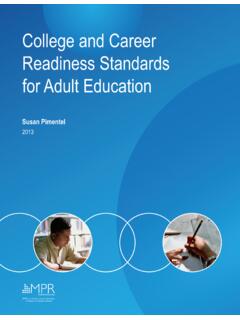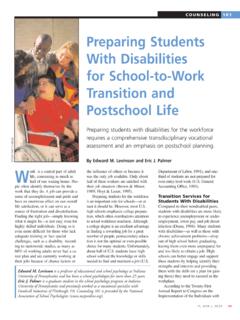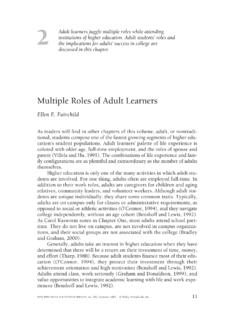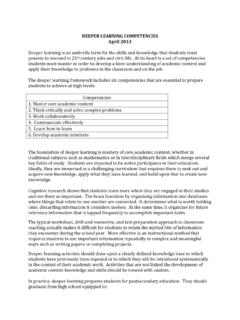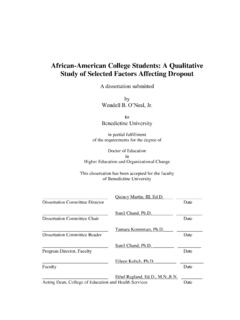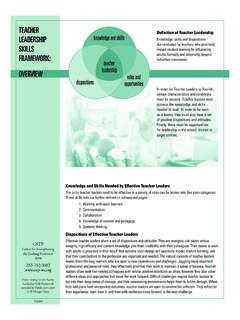Transcription of Accreditation Standards - Accrediting Commission for ...
1 Standard I: Institutional Mission and Effectiveness 1 Accrediting Commission FOR COMMUNITY AND JUNIOR COLLEGES Western Association of Schools and Colleges Accreditation Standards (Adopted June 2014) Introduction1 The primary purpose of an ACCJC accredited institution is to foster student learning and student achievement. An effective institution ensures that its resources, programs, and services, whenever, wherever, and however delivered, support student learning and achievement. The effective institution ensures academic quality and continuous improvement through ongoing assessment of learning and achievement and pursues institutional excellence and improvement through ongoing, integrated planning and evaluation.
2 There are four Standards that work together to define and promote student success , academic quality, institutional integrity, and excellence. The mission provides a framework for all institutional goals and activities. The institution provides the means for students to learn and achieve their goals, assesses how well learning is occurring, and strives to improve learning and achievement through ongoing, systematic, and integrated evaluation and planning (Standard I). Student learning programs and support services make possible the academic quality that supports student success (Standard II). Human, physical, technology, and financial resources enable these programs and services to function and improve (Standard III).
3 Ethical and effective leadership throughout the organization guides the accomplishment of the mission and supports institutional effectiveness and improvement (Standard IV). Integrating the elements of the Standards gives institutions the means to develop a comprehensive assessment of academic quality, institutional integrity and effectiveness, and a path to continuous improvement. Standard I: Mission, Academic Quality and Institutional Effectiveness, and Integrity The institution demonstrates strong commitment to a mission that emphasizes student learning and student achievement. Using analysis of quantitative and qualitative data, the institution continuously and systematically evaluates, plans, implements, and improves the quality of its educational programs and services.
4 The institution demonstrates integrity in all policies, actions, and communication. The administration, faculty, staff, and governing board members act honestly, ethically, and fairly in the performance of their duties. A. Mission 1. The mission describes the institution s broad educational purposes, its intended student population, the types of degrees and other credentials it offers, and its commitment to student learning and student achievement. (ER 6) 1 The Introduction section and opening paragraphs of each Standard are not intended for citation as stand- ards. They are introductory in nature only. Standard I: Institutional Mission and Effectiveness 2 2.
5 The institution uses data to determine how effectively it is accomplishing its mission, and whether the mission directs institutional priorities in meeting the educational needs of students . 3. The institution s programs and services are aligned with its mission. The mission guides institutional decision-making, planning, and resource allocation and informs institutional goals for student learning and achievement. 4. The institution articulates its mission in a widely published statement approved by the governing board. The mission statement is periodically reviewed and updated as necessary. (ER 6) B. Assuring Academic Quality and Institutional Effectiveness Academic Quality 1.
6 The institution demonstrates a sustained, substantive and collegial dialog about student outcomes, student equity, academic quality, institutional effectiveness, and continuous improvement of student learning and achievement. 2. The institution defines and assesses student learning outcomes for all instructional programs and student and learning support services. (ER 11) 3. The institution establishes institution-set Standards for student achievement, appropriate to its mission, assesses how well it is achieving them in pursuit of continuous improvement, and publishes this information. (ER 11) 4. The institution uses assessment data and organizes its institutional processes to support student learning and student achievement.
7 Institutional Effectiveness 5. The institution assesses accomplishment of its mission through program review and evaluation of goals and objectives, student learning outcomes, and student achievement. Quantitative and qualitative data are disaggregated for analysis by program type and mode of delivery. 6. The institution disaggregates and analyzes learning outcomes and achievement for subpopulations of students . When the institution identifies performance gaps, it implements strategies, which may include allocation or reallocation of human, fiscal and other resources, to mitigate those gaps and evaluates the efficacy of those strategies.
8 7. The institution regularly evaluates its policies and practices across all areas of the institution, including instructional programs, student and learning support services, resource management, and governance processes to assure their effectiveness in supporting academic quality and accomplishment of mission. 8. The institution broadly communicates the results of all of its assessment and evaluation activities so that the institution has a shared understanding of its strengths and weaknesses and sets appropriate priorities. Standard I: Institutional Mission and Effectiveness 3 9. The institution engages in continuous, broad based, systematic evaluation and planning.
9 The institution integrates program review, planning, and resource allocation into a comprehensive process that leads to accomplishment of its mission and improvement of institutional effectiveness and academic quality. Institutional planning addresses short- and long-range needs for educational programs and services and for human, physical, technology, and financial resources. (ER 19) C. Institutional Integrity 1. The institution assures the clarity, accuracy, and integrity of information provided to students and prospective students , personnel, and all persons or organizations related to its mission statement, learning outcomes, educational programs, and student support services.
10 The institution gives accurate information to students and the public about its Accreditation status with all of its accreditors. (ER 20) 2. The institution provides a print or online catalog for students and prospective students with precise, accurate, and current information on all facts, requirements, policies, and procedures listed in the Catalog Requirements (see endnote). (ER 20) 3. The institution uses documented assessment of student learning and evaluation of student achievement to communicate matters of academic quality to appropriate constituencies, including current and prospective students and the public.
